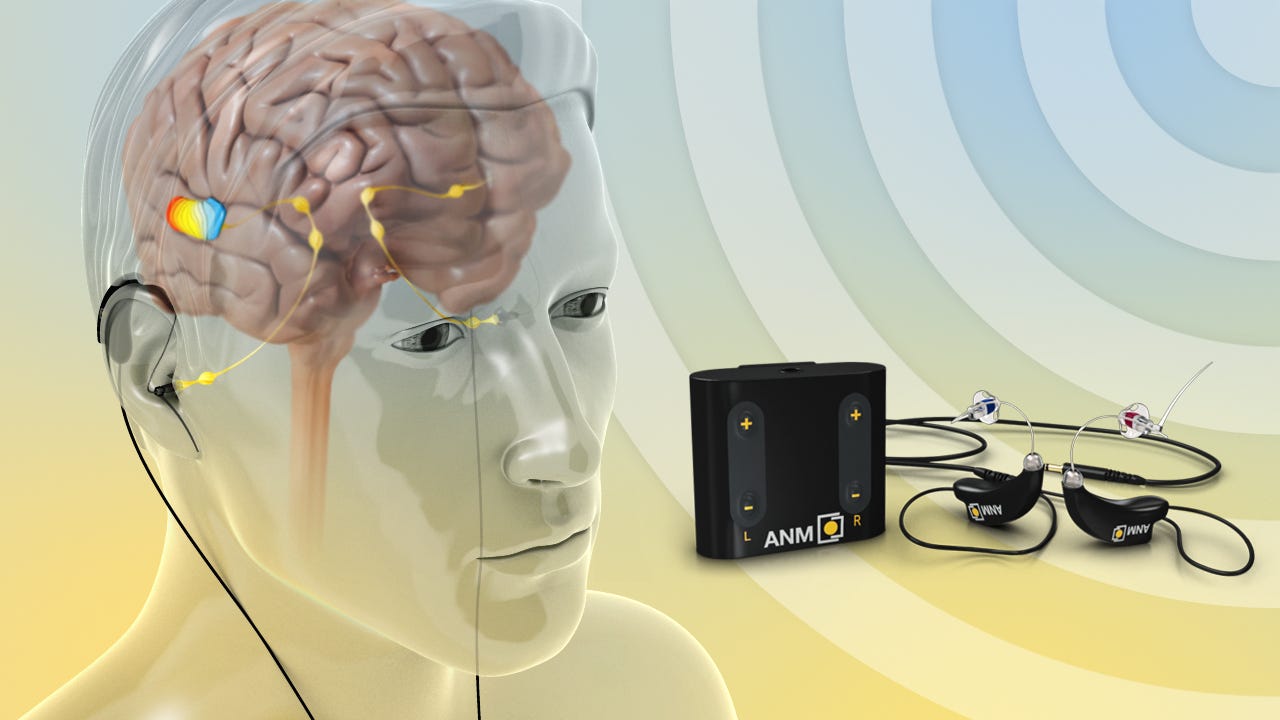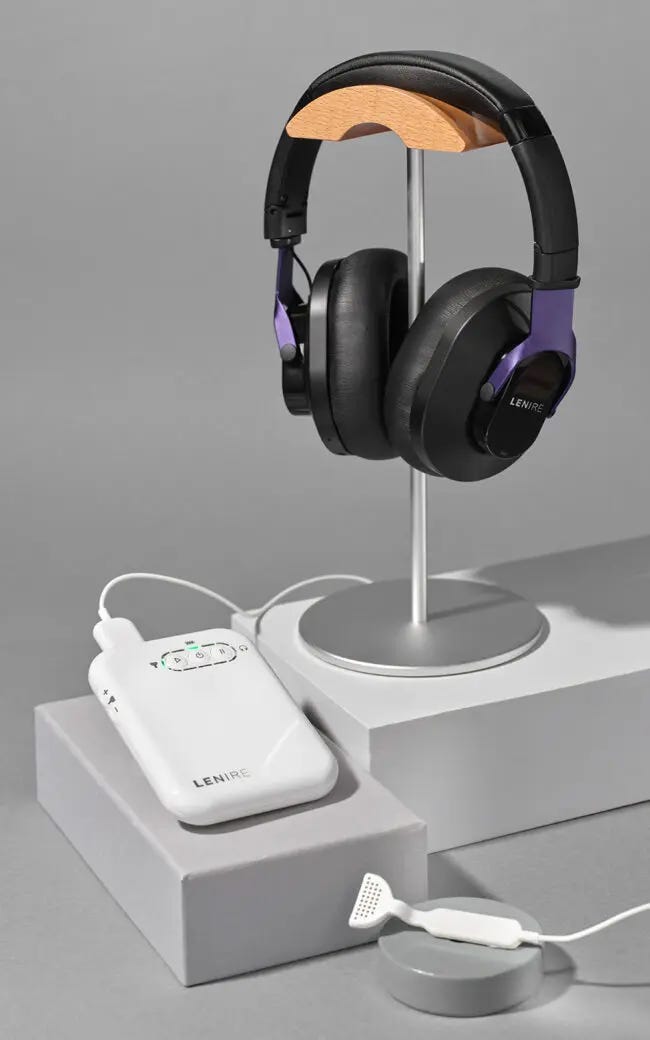Silencing the Ring: Breakthroughs in Tinnitus Treatments You Need to Know
Cutting-Edge Therapies That Promise Peace and Quiet
Hello everyone!
If you're new here, welcome! I recommend starting with Article 1 and Article 2 to get a solid foundation in this intriguing field.
Picture yourself trying to focus on your work or enjoy a quiet evening at home, but a constant, high-pitched ringing in your ears never goes away. For ~15% of the world's population, this is a daily reality due to tinnitus. Even if you don’t suffer from this condition, chances are someone you know does. The impact of tinnitus extends beyond the individual, affecting relationships, productivity, and mental health.
In this issue, we delve into two neuromodulation therapies that are changing lives: Acoustic CR Neuromodulation and Lenire Tinnitus Technology. These innovations promise real relief and a return to peace for millions.
Click here to hear what tinnitus sounds like:
Acoustic CR Neuromodulation: Rewiring the Brain's Rhythms
Acoustic CR Neuromodulation is a therapy designed to help people with tinnitus, a condition where they hear a constant ringing or noise. The goal of this treatment is to "unlearn" or reduce the tinnitus sound by interfering with the abnormal activity of nerve cells in the brain's hearing center.
The therapy uses special sound signals crafted with a mathematical algorithm. These sounds are precisely tuned to match the tinnitus frequency of each patient, making the treatment personalized. This precise tuning ensures the sound signals effectively target the problematic areas in the brain.
One critical aspect of this therapy is spatial control. The auditory cortex, the part of the brain that processes sound, is highly organized. Different areas of this cortex are responsible for different sound frequencies. By finding the exact frequency of the patient’s tinnitus, doctors can send sound signals to the specific area where the nerve cells are overactive.
Another essential factor is chronological control. The timing of the sound signals is crucial. The therapy uses carefully timed impulses to disrupt the abnormal patterns of nerve cell activity. This helps to "reset" the cells and reduce the perception of tinnitus.
Clinical studies have shown that Acoustic CR Neuromodulation can significantly reduce the loudness and annoyance of tinnitus for many patients. About 75% of those treated report positive outcomes, with lasting relief as the therapy normalizes brain activity in tinnitus-related networks. However, the treatment requires precise frequency determination and regular audiologist visits, which might be a drawback for some.
(Image from Cast Pharma)
Lenire Tinnitus Technology: Dual-Mode Stimulation for Enhanced Relief
Lenire offers a new approach to treating tinnitus through a method called bimodal neuromodulation. This means it uses two types of stimulation at the same time: sound and electrical stimulation. The device is designed to help reduce the brain's focus on the tinnitus sound.
Lenire works by combining auditory stimulation with electrical stimulation via the tongue. The idea is that by simultaneously stimulating both the auditory (or hearing) and somatosensory (or touch-related) nerves, the brain can be retrained to pay less attention to the tinnitus sound. This dual-mode stimulation is more effective than just sound therapy alone.
Using Lenire is simple and convenient. It’s a compact device that you can use at home. The device includes wireless headphones and a small handheld controller connected to a tongue stimulator. You listen to specially designed sounds through the headphones while the tongue tip delivers gentle electrical pulses.
Clinical trials have shown promising results. In a major study, 91% of patients experienced sustained relief from tinnitus. They reported a significant reduction in tinnitus severity, which greatly improved their quality of life. The treatment is particularly recommended for people with subjective tinnitus, where the sound is only audible to the person experiencing it.
While Lenire offers many benefits, it does require consistent use and following the treatment regimen closely. This might be challenging for some users. However, its ease of use at home and the strong evidence supporting its effectiveness make it a compelling option for many tinnitus sufferers.
(Image from Lenire’s website)
The Verdict: Hope on the Horizon
Acoustic CR Neuromodulation and Lenire represent exciting advancements in tinnitus treatment, each with unique approaches and benefits. Acoustic CR Neuromodulation's precision and tailored therapy offer a highly effective solution, albeit with the need for frequent professional consultations. Lenire's dual-mode stimulation and at-home convenience provide a compelling alternative, particularly for those with subjective tinnitus.
As research continues to evolve, these neuromodulation therapies offer a beacon of hope for millions suffering from tinnitus. Whether you're drawn to the scientific precision of Acoustic CR Neuromodulation or the innovative dual-mode approach of Lenire, the future looks promising. For more information on therapies for tinnitus or hearing loss, be sure to check out Article 6 and Article 7.
Journeying Forward: The Roadmap to Neuromodulation Awareness
I'm Aditi Doshi, a fifth-year Ph.D. candidate in Neuroscience. My research in non-invasive neuromodulation ignited a passion for translating cutting-edge research into practical applications. NeuroPulse Chronicles, my neuromodulation-themed newsletter, aims to raise awareness about the field and technologies designed to improve lives. In the upcoming edition, I'll delve deeper into different types of neuromodulation and discuss new products that could enhance your lives or the lives of your loved ones.
Subscribe and Stay Informed
If you still need to subscribe, now is the perfect time. Join me on this quest to unravel the mysteries of neuromodulation, and together, let's shine a light on the incredible potential within our brains.
Thank you for being part of the NeuroPulse community!
Cheers,
Aditi Doshi
(Cover Image Credits)





